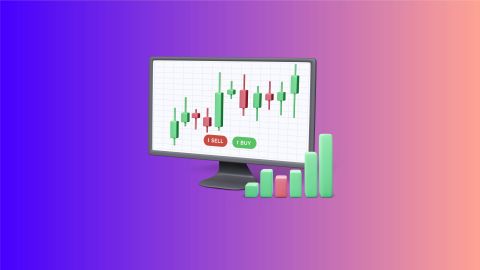Use of technical analysis
Technical analysis plays a vital role in the Indian stock market, aiding traders and investors in decision-making. It is particularly useful for short-term traders looking to capitalise on price fluctuations. Here is how it is used:
- Entry and exit points: Technical analysis helps identify favourable entry and exit points for trades. Traders use patterns and indicators to determine when to buy or sell.
- Risk management: By analysing support and resistance levels, traders can set stop-loss orders to limit potential losses.
- Market sentiment: Technical analysis also reflects market sentiment. A sudden surge in trading volume or a breakout from a trend line can indicate a shift in sentiment.
Additional Read: What is the difference between fundamental and technical analysis
Technical stock market charts
One of the primary tools in technical analysis is stock market charts. These charts display historical price and volume data and are categorised into different types:
- Line charts: Show the closing prices over a specific period, providing a simplified view of the trend.
- Bar charts: Display open, high, low, and close prices for each trading period, offering more detail than line charts.
- Candlestick charts: Present the same information as bar charts but use candlestick patterns to highlight price movements and trend reversals.
Indicators of technical analysis
Technical analysts use a wide range of indicators to make predictions about future price movements. Some commonly used indicators in the Indian stock market include:
- Moving averages: Used to identify trends, moving averages smooth out price data over a specific period.
- Relative strength index (RSI): RSI measures the speed and change of price movements, indicating overbought or oversold conditions.
- MACD (Moving average convergence divergence): Helps identify changes in momentum and potential buy/ sell signals.
Components of trend lines
Trend lines
Trend lines are a fundamental aspect of technical analysis. They represent the direction and strength of a price trend. In an uptrend, a trend line is drawn below the price, connecting the lows, while in a downtrend, it is drawn above, connecting the highs.
Support and resistance
Support and resistance levels are key concepts in technical analysis. Support represents a price level at which a stock tends to find buying interest, preventing it from falling further. Resistance is a level where selling interest typically arises, preventing the stock from rising higher.
Volume
Trading volume is an essential component of technical analysis. It indicates the number of shares or contracts traded during a given period. Unusual spikes in volume can signal significant price movements, while declining volume may indicate a lack of interest.
Technical analysis methods
Here are some widely used technical analysis methods, along with brief explanations of each:
- Trend analysis: This method involves identifying and analysing the prevailing trends in a stock's price movement. Trends can be categorised as uptrends (higher highs and higher lows), downtrends (lower highs and lower lows), or sideways trends (range-bound).
- Support and resistance: Traders look for price levels where a stock tends to find support (stops declining) or resistance (struggles to rise). These levels help determine entry and exit points.
- Bollinger bands: Bollinger bands consist of a moving average (typically 20 periods) with upper and lower bands representing standard deviations from the average. They help identify volatility and potential reversal points.
- Candlestick patterns: Candlestick charts display price movements in a visually informative way. Traders look for patterns like doji, hammer, and engulfing patterns to predict price reversals.
- Fibonacci retracement: This tool uses Fibonacci ratios (for example, 0.618, 0.382) to identify potential support and resistance levels. Traders draw retracement levels from significant price swings.
- Volume analysis: Volume reflects the number of shares or contracts traded during a specific period. Changes in trading volume can signal potential price movements, such as breakouts or reversals.
- Chart patterns: Chart patterns are visual formations in price charts that indicate potential future price movements. Common patterns include head and shoulders, double top/bottom, flags, and triangles.
- Parabolic SAR: The Parabolic SAR (Stop and Reverse) indicator helps identify potential stop and reversal points in price trends. It appears as dots on the price chart.
These are just some of the many technical analysis methods used by traders and investors to analyse and forecast price movements in various financial markets. Keep in mind that no single method guarantees success, and many traders use a combination of these techniques to make informed decisions.
Advantages and disadvantages of technical analysis:
Pros of technical analysis
|
Cons of technical analysis
|
It relies on quantifiable data, making it less subjective than fundamental analysis.
|
It may not provide sufficient insights for long-term investment decisions.
|
Ideal for short-term traders looking to profit from price fluctuations.
|
Technical analysis does not guarantee accurate predictions; it is based on probabilities.
|
Technical analysis can be used in various markets, including stocks, commodities, and cryptocurrencies.
|
It does not account for a company's financial health or external factors affecting the stock.
|
Technical analysis vs. fundamental analysis
Technical analysis and fundamental analysis are two principal approaches used in the Indian securities market to evaluate and select stocks. Both methods have distinct methodologies, focuses, and applications. Here’s a detailed comparison:
Aspect
|
Technical analysis
|
Fundamental analysis
|
Definition
|
A method that uses historical market data, primarily price and volume, to predict future movements.
|
A method that evaluates a company's financial health and market position to determine its value.
|
Focus
|
Focuses on price movements, market trends, and patterns.
|
Focuses on economic, financial, and other qualitative and quantitative factors.
|
Data used
|
Uses price charts, volume, and other market-generated data.
|
Uses financial statements, economic reports, company assets, and market data.
|
Goal
|
To predict the direction of future prices based on past market data.
|
To estimate the intrinsic value of a stock and determine whether it is undervalued or overvalued.
|
Time horizon
|
Typically used for short-term to intermediate-term trading.
|
Generally used for long-term investment decisions.
|
Tools
|
Utilises tools such as charts, technical indicators (RSI, MACD), trend lines, and candlestick patterns.
|
Employs tools like P/E ratio, P/B ratio, ROE, DCF analysis, and economic indicators.
|
Decision basis
|
Decisions are based on chart patterns, trends, and trading signals.
|
Decisions are based on economic outlook, industry health, and company performance.
|
Investor profile
|
Appeals to traders and those looking for short-term gains.
|
Attracts long-term investors focused on growth and value.
|
Market psychology
|
Heavily reliant on interpreting trader psychology and market sentiment.
|
Less influenced by market sentiment, focusing more on long-term business prospects.
|
Key criticism
|
Can be seen as self-fulfilling and dismissive of broader market fundamentals.
|
Can be cumbersome and slow to react to immediate market trends and economic changes.
|
Conclusion
Technical analysis is a valuable for trading, helping traders and investors make informed decisions based on historical price and volume data. While it has its advantages and limitations, it remains a popular method for those seeking to navigate the dynamic world of stock trading. Understanding the components and indicators of technical analysis can provide valuable insights for anyone looking to participate in the Indian stock market.
Related articles





